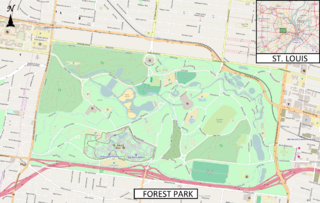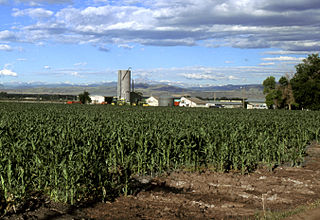
Missouri is a state in the Midwestern region of the United States. With more than six million residents, it is the 19th-most populous state of the country. The largest urban areas are St. Louis, Kansas City, Springfield and Columbia; the capital is Jefferson City. The state is the 21st-most extensive in area. Missouri is bordered by eight states : Iowa to the north, Illinois, Kentucky and Tennessee to the east, Arkansas to the south and Oklahoma, Kansas and Nebraska to the west. In the south are the Ozarks, a forested highland, providing timber, minerals, and recreation. The Missouri River, after which the state is named, flows through the center of the state into the Mississippi River, which makes up Missouri's eastern border.

St. Louis is the second-largest city in Missouri, United States. It sits near the confluence of the Mississippi and the Missouri Rivers, on the western bank of the latter. As of 2019, the city proper had an estimated population of around 300,000, while the bi-state metropolitan area, which extends into Illinois, had an estimated population of over 2.8 million, making it the largest metropolitan area in Missouri, the second-largest in Illinois, the seventh-largest in the Great Lakes Megalopolis, and the 20th-largest in the United States.

St. Louis County is located in the eastern-central portion of Missouri. It is bounded by the City of St. Louis and the Mississippi River to the east, the Missouri River to the north, and the Meramec River to the south. As of the 2019 Census Bureau population estimate, the population was 994,205, making it the most populous county in Missouri. Its county seat is Clayton. The county is included in the St. Louis, MO–IL metropolitan statistical area.

The Saint Louis Zoo, officially the Saint Louis Zoological Park, is a zoo in Forest Park, St. Louis, Missouri. It is recognized as a leading zoo in animal management, research, conservation, and education. The zoo is accredited by the Association of Zoos and Aquariums (AZA). Admission is free based on a public subsidy from a cultural tax district, the Metropolitan Zoological Park and Museum District (ZMD); fees are charged for some special attractions. A special feature is the 2 ft narrow gauge Emerson Zooline Railroad with passenger trains pulled by Chance Rides C.P. Huntington locomotives that encircle the zoo, stopping at the more popular attractions.

The Missouri Botanical Garden is a botanical garden located at 4344 Shaw Boulevard in St. Louis, Missouri. It is also known informally as Shaw's Garden for founder and philanthropist Henry Shaw. Its herbarium, with more than 6.6 million specimens, is the second largest in North America, behind that of the New York Botanical Garden.

Proposition 13 is an amendment of the Constitution of California enacted during 1978, by means of the initiative process. The initiative was approved by California voters on June 6, 1978. It was upheld as constitutional by the United States Supreme Court in the case of Nordlinger v. Hahn, 505 U.S. 1 (1992). Proposition 13 is embodied in Article XIII A of the Constitution of the State of California.

The Sunken Gardens are 4 acres of well-established botanical gardens, located in the Historic Old Northeast neighborhood of St. Petersburg, Florida, at 1825 4th Street North. The Gardens have existed for more than a century, and are one of the oldest roadside tourist attractions in the United States. The Gardens are now operated by the City of St. Petersburg, and maintained with the help of volunteers. Sunken Gardens are open to the public every day of the week. An admission fee is charged for entrance into the gardens and a yearly membership is also available.

Sales taxes in the United States are taxes placed on the sale or lease of goods and services in the United States. Sales tax is governed at the state level and no national general sales tax exists. 45 states, the District of Columbia, the territories of Puerto Rico, and Guam impose general sales taxes that apply to the sale or lease of most goods and some services, and states also may levy selective sales taxes on the sale or lease of particular goods or services. States may grant local governments the authority to impose additional general or selective sales taxes.

Metro Transit is an enterprise of Bi-State Development, an interstate compact formed by Missouri and Illinois in 1949. Its operating budget in 2016 was $280 million, which is funded by sales taxes from the City of St. Louis and St. Louis County, the St. Clair County Illinois Transit District, federal and state grants and subsidies, and through fare paying passengers.

The economy of the State of Colorado is ranked 20th largest in the United States in 2008. According to The Bureau of Economic Analysis, the gross state product estimates for 2008 was $248.6 billion. Colorado's per capita personal income in 2003 was $34,561, putting Colorado 8th in the nation.

Proposition 218 is an adopted initiative constitutional amendment which revolutionized local and regional government finance in California. Called the "Right to Vote on Taxes Act," it was sponsored by the Howard Jarvis Taxpayers Association as a constitutional follow-up to the landmark property tax reduction initiative constitutional amendment, Proposition 13, approved in 1978. Proposition 218 was approved by California voters during the November 5, 1996, statewide general election.

Shaw is a neighborhood in St. Louis, Missouri. It is bordered on the North by Interstate 44, the east by S. Grand Blvd., the west by Tower Grove Ave and the Missouri Botanical Gardens, and the south by Tower Grove Park. The Shaw Neighborhood is a local historic district whose historic structure and character is protected by ordinance.

Southampton is a neighborhood in St. Louis, Missouri. Located in the southwestern reaches of the city, its borders are Chippewa Street on the north, Hampton Avenue on the west, Eichelberger Street on the south, and South Kingshighway Boulevard on the east.
The Allegheny Regional Asset District (RAD) is a special purpose unit of local government in Allegheny County, Pennsylvania. Its physical boundaries are the same as those of Allegheny County, and include the City of Pittsburgh.

Forest Park Southeast (FPSE) is a neighborhood of St. Louis, Missouri. It is bordered by Interstate 64 to the north, Vandeventer Avenue to the east, Interstate 44 to the south, and Kingshighway Boulevard and Forest Park to the west. Adjoining neighborhoods include Kings Oak and The Hill to the west, Southwest Garden to the south, Botanical Heights to the southeast, Midtown to the east, and the Central West End to the north.

The following is an alphabetical list of articles related to the U.S. state of Missouri.

The University of Missouri–St. Louis (UMSL) is a public research university in St. Louis County, Missouri. Established in 1963, it is one of four universities in the University of Missouri System and its newest. UMSL's campus is located on the former grounds of the Bellerive Country Club in St. Louis County, with an address in St. Louis city. The campus stretches into the municipalities of Bellerive, Bel-Nor and Normandy. Additional facilities are located at the former site of Marillac College and at Grand Center, both in St. Louis city.
Missouri Coalition for the Environment, a non-profit, non-partisan, 501(c)(3) state-level conservation organization, campaigns for clean air, clean water and clean energy in Missouri. The organization is member and grant supported.

Lesbian, gay, bisexual, transgender, and queer (LGBTQ) persons in the U.S. state of Missouri as of late have most of the same legal rights as non-LGBT persons have, but nonetheless face some legal challenges not experienced by other residents throughout the state, excluding St. Louis, Kansas City, and Columbia. Same-sex sexual activity is legal in Missouri.

Cannabis in Missouri is illegal for recreational use, but decriminalized through legislation passed in 2014. Medical use was legalized in 2018 through a ballot initiative to amend the state constitution. The first licensed sales began in October 2020.















